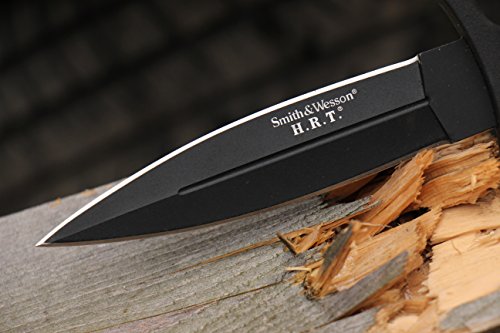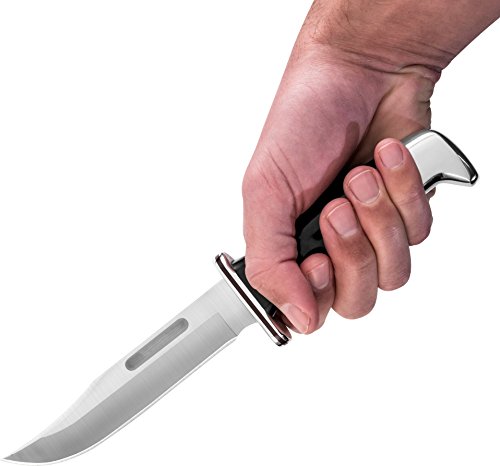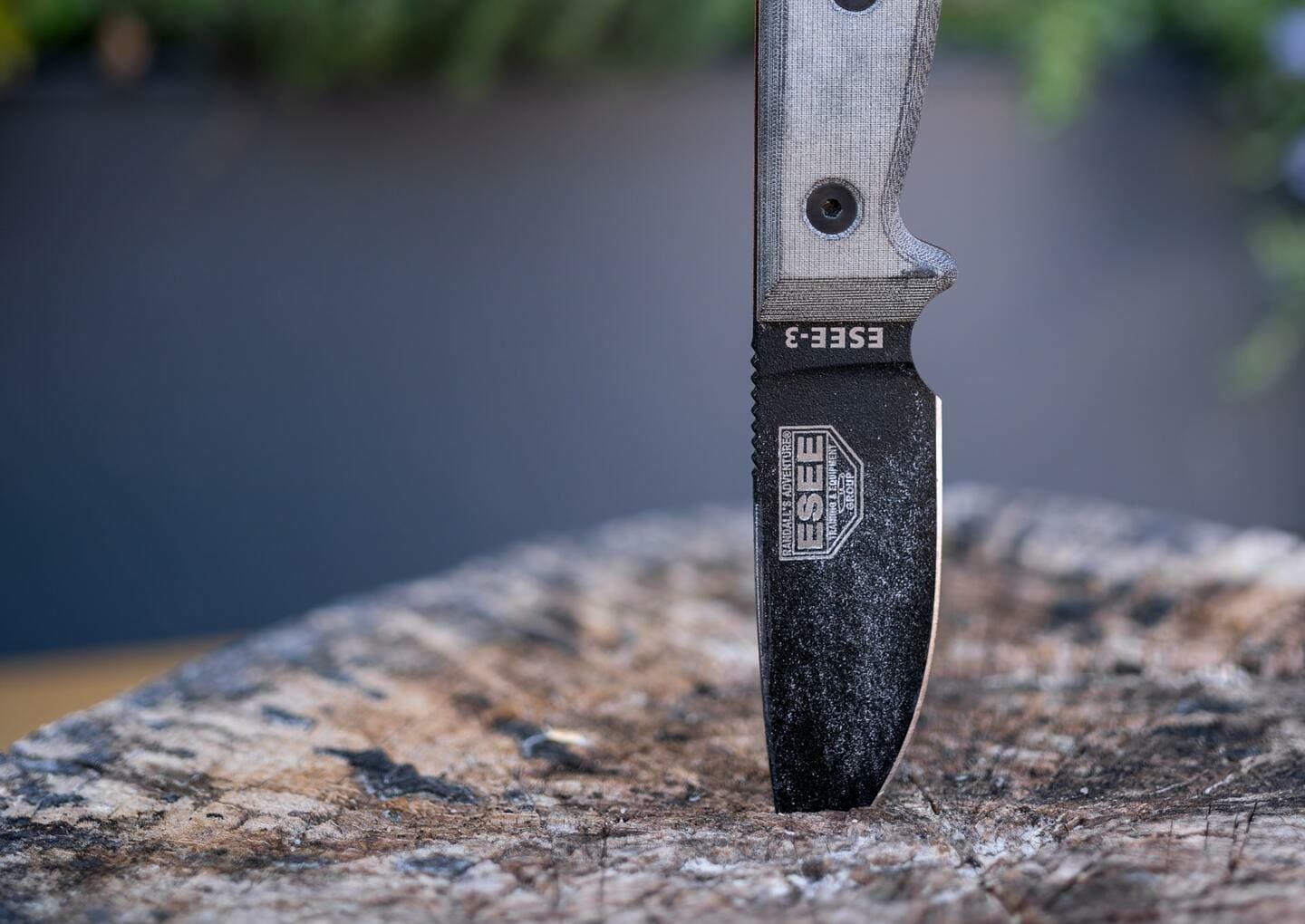Preparation is the key to handle any survival situation. That’s why having the best fixed blade survival knife will make you feel ready to take on anything. It’s tougher and more durable than a pocket knife, and as a result, will help you to face extreme situations with confidence. With such a wide choice of knives available on the market, it can be challenging to choose one that works for you. That’s why we’ve carefully reviewed five products to help you find the best fixed blade survival knife to assist you when you need it the most. Take a look at our reviews, and, along with our handy buyer’s guide, we’re sure you’ll soon have the best fixed blade survival knife packed away in your survival kit.
Smith & Wesson SWHRT9B Fixed Blade Knife
The Smith & Wesson SWHRT9B Fixed Blade Knife is convenient for almost any survival situation.
That comes with a sheath that can attach to your belt or boot for easy access in the wilderness, whilst also adding protection for the blade itself.
The Smith & Wesson fixed blade knife is full tang, with a blade length of 4.7 inches and weighs 7.7oz, making it super lightweight. It has a double-edge blade, which means it is very sharp and ideal for both fine cutting tasks and self-defense.
It is made from high carbon stainless steel, so should be durable against rust and corrosion.
The Smith & Wesson fixed blade knife features a black rubber wrapped handle and a has a handguard, to prevent slipping and improve your overall grip.
Read the full post_title; ?> review
Pros
- Small blade is ideal for fine cutting
- Double-edged blade makes it sharp and powerful enough for self-defense
- Full tang construction
- Lightweight
- Easy access with attachable sheath
- Durable stainless steel design
- Includes a handguard for safety
- Budget-friendly
Cons
- Some customers have found that it isn't the best quality knife, and not as sharp as competitor knives
ESEE Knives 6P Fixed Blade Knife
This ESEE Knives 6P Fixed Blade Knife is made from 1095 high carbon steel, meaning it is another great option as a wilderness survival knife. It has a full tang construction, along with a Micarta canvas handle, for a comfortable and non-slip grip.
The high-quality steel makes it perfect for heavy-duty chopping and cutting through the toughest of material. Essentially, there’s not much that the ESEE 6P Fixed Blade Knife can’t slice through, it’s a fantastic piece of kit.
The ESEE fixed blade knife is 6.5 inches in length, which gives it a good balance between being a heavy-duty knife whilst also being a very accurate cutting knife. It is both powerful and precise and more than able to get the job done in a variety of survival and tactical situations.
This knife features a drop point blade, which means the tip is well-positioned for good control. It has a flat grind, which makes it razor-sharp enough to cut through almost anything.
Read the full post_title; ?> review
Pros
- Blade length is excellent for fine cutting and heavy-duty chopping
- High-quality and durable carbon steel construction
- Full tang construction
- Handle is comfortable and has a non-slip grip
- Flat grind provides sharpness
Cons
- High carbon steel means it will require more maintenance to prevent rust and corrosion
ESEE Junglas Fixed Blade Knife
The ESEE Junglas Fixed Blade Knife also happens to be the longest fixed blade knife that we have featured today.
The blade is 10.5 inches, weighing around 22.5oz and is made from 1095 high carbon steel.
Such a durable and tough knife is exactly what you’ll need in any survival situation. It is ideal for chopping, due to its thickness and the long drop point and the handle is made from Micarta canvas, giving you a firm grip and a long-lasting handle that shouldn’t fall apart unexpectedly.
In addition to the ESEE Junglas Fixed Blade Knife, you’ll also get a Kydex sheath included. This is great for protecting your knife, and it comes with MOLLE backing, so you can easily attach it to your survival backpack or belt strap where possible.
Read the full post_title; ?> review
Pros
- Heavy-duty and durable blade
- High-quality 1095 high carbon steel
- Comfortable handle provides a firm grip
- MOLLE backing makes sheath easy to attach to survival gear
- Full tang construction
Cons
- Heavier than other models
- High carbon steel means it will require more maintenance to prevent rust and corrosion
- Not budget-friendly
Gerber StrongArm Fixed Blade Knife
Here we go with another Gerber product on our best survival knives comparison – the StrongArm Fixed Blade Knife. It is a bit better than Gerber’s Bear Grylls version, and I’ll explain why in a second.
Let’s start with the blade material. While the Bear Grylls’ blade is made of high carbon steel without any more indications about the quality of the material, the StrongArm blade is made of very high-quality material – 420HC steel. The 420HC steel is one of the strongest and most durable steels on the market, and it is a genuinely premium metal.
The Gerber’s StrongArm survival knife is a full-tang blade with a diamond textured rubber grip. It has a unique feature built in the handle – there is a sharp striking pommel at the end of it. It can prove extremely useful in survival and rescue operations where you need to shatter a hard surface like a car window or thick ice, for example.
The sheath of the StrongArm knife is probably one of the best we’ve seen so far. It offers more than a few unique mounting options. You can mount it on a MOLLE gear, carry it on your ankle, wear it on your belt.
Overall the StrongArm knife made by Gerber is a superb product trusted by military and rescue personnel. They recently upgraded the steel to a 420HC grade – vastly improving the strength and the edge retention of the blade. The striking pommel can be the difference between life and death in certain situations, and the excellent is one of the best we’ve seen equipped lately. It is a solid choice for bushcraft, camping, and even military use.
Read the full post_title; ?> review
Pros
- Full tang blade
- 420HC steel blade
- Striking pommel handle
- Detachable belt hoops and sheath with MOLLE strap
- Made in USA
Cons
- Uneven blade angle from the factory
- Not suitable for heavy-duty chopping
Buck Knives 119 Special Fixed Blade Knife
The Buck Knives 119 Special Fixed Blade Knife has a 6-inch clip point blade, giving you precise control while still being able to handle heavy-duty chopping.
However, its sharp tip is ideal for piercing and cutting in hard-to-reach places.
The robust blade is designed from 420 high carbon stainless steel and has a Rockwell Hardness rating of 58 HRC. This means that not only will it be durable against corrosion and rust, but it is also sturdy enough to perform the toughest of survival tasks.
The Buck Knives 119 Special Fixed Blade Knife has a comfortable grip that features a black phenolic handle and has palm swells, along with an aluminum double finger guard. This unique handle design makes the 119 Special Fixed Blade Knife a safe and reliable blade for use in a wide range of survival situations.
In addition to the blade itself, the knife comes with a pouch-style leather sheath, with a fold-over flap for easy access.
Read the full post_title; ?> review
Pros
- Blade length makes it great for fine cutting, as well as more heavy-duty tasks
- Durable against corrosion and rust
- Comfortable and safe grip
- Easy access leather sheath
- Lightweight
Cons
- Some customers have taken issue with the quality and have found that the knife has blemishes on the blade
Blade Tip and Thickness
The overall design of the blade is crucial in determining how well it will work in a survival situation. In many survival situations, it is likely that you would use the full length of the cutting edge of the knife, and the tip of it for piercing if need be. With this in mind, it’s important to understand the different types of blade design you’ll encounter when looking for the best fixed blade survival knife. When it comes to survival, it’s recommended to choose a blade that has either a clip point, a drop point, or a spear point design. These designs position the tip so that it is nearer to the middle line of the blade, which gives you more precise control than an otherwise straight back construction. In addition to positioning the blade tip, these blade designs will also lighten the tip, which balances the blade near to hilt, therefore providing you with greater control over the tip. In terms of blade thickness, this is usually determined by the length and size of the blade itself. A thicker blade will be heavier, so consider this if you are looking to travel as light as possible. It is also worth noting that the more you sharpen a blade, the more it will thin out.
Blade Edge
It’s essential to consider the cutting edge when choosing a fixed blade knife, as each type of edge will suit an appropriate purpose.
Straight Edge
Straight cutting edges are typically considered as edges that can work for general purposes. They can, however, differ depending on the rake angle they have. Measured from the bolster, straight cutting edges will have either a positive, neutral, or negative rake angle. It is common to find a straight cutting edge with a neutral rake angle, which means the angle extends at a right angle from the bolster. In contrast, a positive rake angle will extend downward from the bolster, and a negative rake angle will extend upward. Straight edges work well for skinning or scaling, and are the easiest type of edge to sharpen.
Serrated Edge
A serrated edge is another common edge that you’ll encounter. It is defined by its ‘teeth,’ which can differ in style and depth. Serrated edges are ideal for cutting through tough materials such as branches and rope, and can help to form a ripping action. However, these edges are quite difficult to sharpen, so bear this in mind if you don’t want to go through the extra effort of this prior to your survival hike. A serrated edge may work best for your intended purpose, so it might be worthwhile despite it being harder to sharpen.
Combination Edge
As its name suggests, a combination edge is a blend of both a straight and serrated edge. Typically, the serrated part will be on the spine of the knife, or positioned ahead of the handle. With this kind of edge, you get the best of both worlds. You can utilize both aspects of a serrated and straight edge, without having to carry two knives at once. If you’re familiar with our articles, you know how much we believe in the power of multipurpose tools for survival, and that’s why this is a feature worth considering if you’re serious about survival and want to save space in your backpack.
Blade Length
The length of the blade is an essential factor when choosing the best fixed blade survival knife. It is useful to consider how you intend to use the knife when looking into the length. A blade length between 3.5 to 5 inches will suit delicate cutting tasks, such as skinning small game animals, gutting fish, and cutting notches in stakes. However, for more extreme survival scenarios, such as severe chopping or self-defense, a longer blade will be more appropriate. A blade length of around 8 to 10 inches should be long enough to perform well against these kinds of tasks. However, you’ll usually have to work a bit harder to control the tip of these longer blades if you want to execute more precise cutting tasks. With these differences in mind, it may be worth considering a blade that falls somewhere in between these lengths. A blade of around 6 to 7.5 inches could combine the power of a longer blade, with the control and accuracy of a smaller one.
Blade Steel
The material of the blade will also affect how it performs. While stainless steel is a commonly used material, it is not the most durable and might not cut so well through tough items in the wilderness. A tougher, more durable kind of steel to consider is carbon steel. Carbon steel is better suited to chopping and cutting through most materials, but bear in mind that it is more prone to rust and corrosion when in contact with moisture. You can assess the toughness of a blade by what’s known as its Rockwell Hardness (sometimes abbreviated to HRC). Blades with a HRC of between 50 to 54 are considered the most durable. Generally, longer, thicker blades will be constructed with non-stainless, high carbon steel. However, smaller, shorter blades are typically made with either stainless or carbon steel, and will have a higher Rockwell Hardness rating, so look out for these specifications before you make a purchase.
Blade Grind
The ‘grind’ part of a blade is the shape of the cross-section of the blade, which shows how the blade thins out to reveal the cutting edge. There are several kinds of grind that a blade could have, but in terms of survival knives, you should look for blades with a saber or a flat grind. You can determine what kind of grind a blade has by looking at the bevel. The bevel is the term used to describe the surface that has been ground to create the knife’s edge. If you look closely at a knife, you will be able to see a slight angle on both sides, or just on one side, that will continue to the edge of the knife. This angle is what’s referred to as the ‘bevel’ of the knife, with an angle on both sides known as a ‘double bevel.’ A saber grind will have a bevel that extends a short distance from the edge to the back of the blade. These grinds allow for a thick blade that can hold an edge when chopping or splitting. Be aware, however, that blades with a saber grind aren’t the easiest to finely sharpen. In contrast, a flat grind will feature a bevel that extends in all ways from the cutting edge to the back of the blade. This means the edge is really sharp, but it is not particularly durable, so it is worth considering what you intend to use the knife for in a survival situation.
Tang
The tang is the part of the blade that stretches into the handle. Generally, it’s believed that the more of the blade that goes into the handle, the more sturdy and safe the knife will be. That’s why a knife with full tang is considered a sensible option for survival. Knives with full tang will have both sides of the handle fixed onto either side of the blade for maximum stability. However, some knives will have what’s known as ‘partial tang.’ It’s not advised to choose a partial tang knife as your survival knife. This is because it will be weaker than a full tang knife, as less of the blade extends into the handle. This makes the knife more prone to breakage between the blade and the handle. While partial tangs can be lightweight, with less metal to weight them down, it is not the most reliable choice for survival.
Handle
The handle shouldn’t be overlooked when choosing a fixed blade survival knife. A sturdy and well-made handle will enhance the knife’s overall performance. The best fixed blade survival knife will have a handle that can resist moisture damage, as well as being sturdy enough to not separate from the blade or break off. You will need a handle that gives you a good, firm grip, and this is determined by the material it’s constructed with. Most survival knife handles are designed from canvas or linen Micarta. These are solid materials that provide a sturdy grip. Some handles are also made from fiber-reinforced plastics. These work well too in terms of durability, but you should bear in mind that there’s no cushion to prevent shock when using the knife. For heavy-duty knives, textured rubber handles can provide good support as well, along with durability for a long-lasting knife.
Recap
With all of the factors taken into consideration, my pick for the best fixed blade survival knife would be ESEE Knives 6P Fixed Blade Knife. What makes this blade stand out is its multiple capabilities. It works well at both heavy-duty tasks, and more precise cutting, which is exactly what you need from the best fixed blade survival knife. Thanks for reading, and we hope our reviews have made it easier for you to find the best fixed blade survival knife for you. Please leave any feedback in the comments section below! If you have any suggestions for future topics, please get in touch with us. We’d love to hear from other survivalists and hear your ideas! Good Luck and Happy Survival Prepping!
Share the Love
If you found this post useful, please let others know about it by sharing it.

































